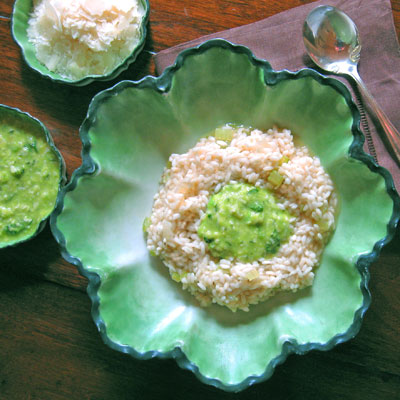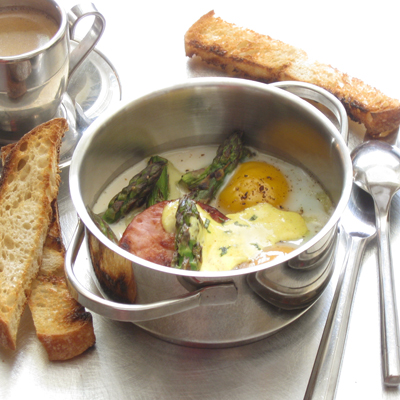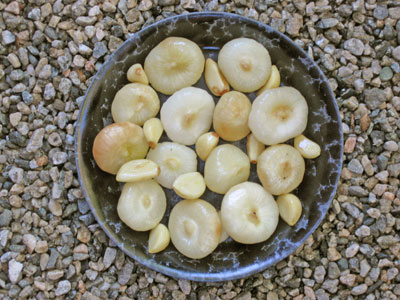
The delicate nature of fava beans requires a simple clean accompaniment. I chose a classic white risotto. Please note that the young fava beans are easy to over cook. So this risotto brings the fresh beans forward as a puree. This gives the cook a lot of control because the beans may be barely cooked then stirred into risotto at the table at the last moment.

Ingredients
- 4¼ cup broth
- 2 tablespoon olive oil
- 6 tablespoon unsalted butter
- 1 onion, finely chopped
- 4 clove garlic cloves, peeled and minced
- 3 stalks celery, cut in ¼” dice
- 2 cup aborio rice
- 2 cup dry white wine
- sea salt or kosher salt and freshly ground black pepper
- ½ cup plus 2 tablespoons, very good olive oil
- 1 cup fava beans, out of the pod
- 1 teaspoon thyme leaves, finely chopped
- ½ cup loosely packed italian parsley, leaves only
- ½ cup pecorino romano, grated, plus more for garnish
Directions
Risotto Bianco
Bring the 4 cups of chicken broth to a simmer.
Put the 2 T olive oil and 1 T butter into a separate slope-sided pan, add the onion, garlic, and celery, and cook very slowly over medium heat for about 15 minutes without coloring. When the vegetables have softened, add the rice and turn up the heat to medium-high.
The rice will now begin to lightly fry, so keep stirring it. After a minute it will look slightly translucent. Add the wine and keep stirring.
Once the wine has cooked into the rice, add your first ladle of hot stock and a pinch of salt. Turn the heat down to a simmer so the rice doesn’t cook too quickly on the outside. Keep adding ladle fulls of stock, stirring as you go, allowing each ladle full to be absorbed before adding the next. This will take around 15 minutes.
Remove from the heat and add 4 T butter and ½ C Pecorino Romano. Stir well. Place a lid on the pan and allow to sit for 2 minutes. This will keep it from getting overcooked and allow it to get creamy.
Fava Bean Puree
Place the fava beans in a heat proof bowl. Pour enough boiling water over the beans to cover by about 1‑inch. Let the beans sit undisturbed until the water has cooled enough so as to handle the beans.
Start peeling the beans by using your thumbnail to nick a slit in the skin. Squeeze slightly, and the inner bean will pop right out. If possible start with the smaller beans working to the largest beans.
Heat the 2 tablespoons of very good olive oil in a small saute pan over medium-high heat. Add the garlic and cook, stirring often until just beginning to brown.
Scrape the garlic and it’s oil into a food processor and add the fava beans, the remaining ½ cup of very good olive oil, salt and pepper, parsley, and the thyme. Pulse the mixture 5 or 6 times to get a rough puree. Add the chicken stock and blend a few seconds until somewhat smooth. Leave a little texture if possible. The puree will keep for 1 week covered in your refrigerator.
To Serve
Spoon the warm risotto into 4 serving bowls and top each with an even amount of fava bean puree. Serve each with some of the remaining Pecorino Romano.


oh, I love a really good melon. So satisfying!
Including the melon and prosciutto match is always a treat, even if it’s autumn already! Yes, today is the first day of the Autumnal Equinox!
Interesting take on the prosciutto and melon! Oddly enough, I was at a restaurant in Montepulciano this summer, and they used “Jamaican” pepper with it. Totally to die for, as is your version! Fantastic!
I’ve had prosciutto wrapped pears with basil before. I thought it was an interesting combination between the sweet and savory. I can imagine melon and prosciutto has a sweet and savoriness to it as well.
Even though summer does seem to linger here as Jenn stated, I have a feeling there is still growing seasons here!? ( I may be wrong) I have always enoyed melon and prosciutto, it’s simple and delicious. The addition of anise is interesting, I did a considerable amount of experimenting with it in desserts in class.
I’ve really enjoyed swapping melon with asian pears when it comes to prosciutto wraps. Little bit of pepper or chive can go a long way when balancing with the sweetness of the fruit, or balsamic vinegar if used.
The anise I had never considered, and will have to play with immediately.
To be quite honest, I haven’t had melon and prosciutto yet. I know, I know. I’m missing out. And I’ve had some pretty good melons lately too. Why I haven’t thought of this. I’m not sure. Summer pretty much lingers here in LA, so I think I’ve got a couple days to fit this into the end of summer feasting.
Also, those are some very good tips on choosing the right ripe melon. I’ve found myself picking one that’s not too appetizing before.